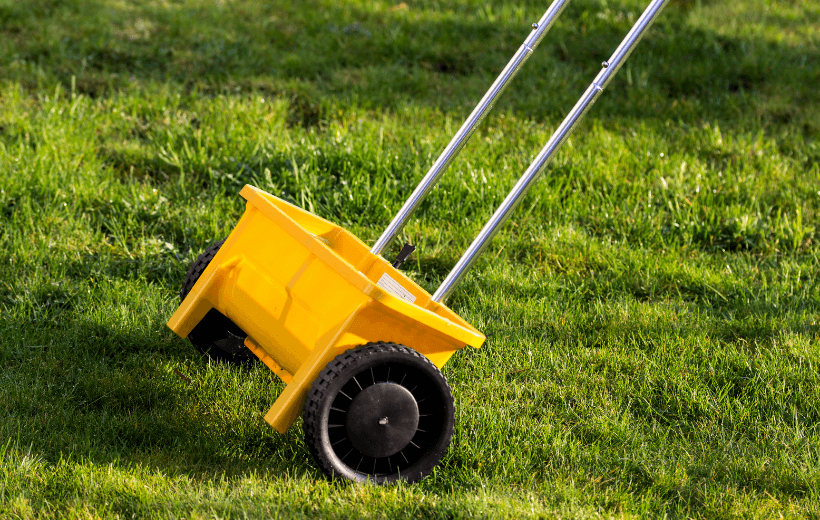The Dangers of Over-Fertilizing and How to Apply Fertilizer Correctly
A healthy, green lawn is a goal for many homeowners, and proper fertilization plays a big role in achieving that. However, using too much fertilizer or applying it incorrectly can do more harm than good. Over-fertilizing can weaken your grass, harm the environment, and even cost you more in the long run. Understanding the risks and best practices for fertilizing your lawn can help you maintain a lush, thriving yard.

The Risks of Over-Fertilizing
Applying too much fertilizer might seem like a good idea to speed up growth, but it often leads to negative consequences. Here are some of the dangers:
1. Burning Your Grass
Many fertilizers contain high amounts of nitrogen, which is essential for plant growth. However, too much nitrogen can cause fertilizer burn, which appears as yellow or brown patches in your grass. This happens because excess salts in the fertilizer pull moisture out of the grass blades, causing them to dry out and die.
2. Weakening Root Growth
Too much fertilizer can encourage excessive top growth while weakening the root system. This leads to shallow roots that struggle to absorb water and nutrients properly, making your lawn more vulnerable to drought, disease, and stress.
3. Encouraging Thatch Buildup
Thatch is a layer of dead grass, roots, and organic matter that builds up between the soil and the grass blades. Over-fertilization can cause thatch to accumulate faster than it decomposes, leading to poor water absorption and increasing the risk of lawn diseases.
4. Promoting Disease and Pest Problems
A lawn that grows too quickly due to excessive fertilization is more susceptible to fungal diseases like brown patch and dollar spot. Pests, such as grubs and chinch bugs, are also attracted to over-fertilized lawns, leading to additional maintenance issues.
5. Polluting the Environment
Excess fertilizer can run off into storm drains, lakes, and rivers, causing water pollution. High levels of nitrogen and phosphorus in waterways lead to algae blooms, which deplete oxygen levels and harm aquatic life. Applying the right amount of fertilizer reduces this environmental impact.
How to Apply Fertilizer Correctly
Now that you understand the risks, let’s look at the best ways to fertilize your lawn for healthy, sustainable growth.
1. Test Your Soil First
Before applying fertilizer, test your soil to determine its nutrient levels. A soil test will tell you exactly what your lawn needs, helping you avoid unnecessary applications. You can purchase a soil test kit or send a sample to your local extension service.
2. Choose the Right Fertilizer
Selecting the right type of fertilizer is essential for balanced growth. Here are a few key points:
- Use a slow-release fertilizer to provide nutrients gradually and prevent excessive growth.
- Look for a balanced N-P-K ratio (Nitrogen-Phosphorus-Potassium) suited to your grass type.
- Organic fertilizers, such as compost or manure, can improve soil health over time without the risk of over-fertilizing.
3. Follow the Application Rate
Always read and follow the manufacturer’s instructions on fertilizer bags. Applying more than the recommended amount will not speed up growth; it will only increase the risk of damage. Generally, lawns in Fort Worth benefit from around 1 pound of nitrogen per 1,000 square feet per growing season.
4. Time Your Applications Properly
Timing is crucial for effective fertilization. The best times to fertilize are:
- Spring (March–April): Helps jumpstart growth after winter dormancy.
- Early Summer (June–July): Supports strong root development before the heat peaks.
- Fall (September–October): Prepares grass for winter dormancy and encourages healthy spring growth.
Avoid fertilizing during extreme heat or drought, as this can stress the grass and increase the risk of fertilizer burn.
5. Water After Fertilizing
Light watering after applying fertilizer helps nutrients soak into the soil and prevents runoff. However, avoid heavy watering immediately after application, as it can wash the fertilizer away before it gets absorbed.
6. Use a Spreader for Even Distribution
Uneven fertilizer application can lead to patchy growth and burned spots. A broadcast or drop spreader ensures even coverage, reducing the risk of over-fertilization in certain areas.
7. Leave Grass Clippings on the Lawn
Grass clippings act as a natural fertilizer, returning nutrients to the soil. This reduces the need for additional fertilization and promotes a more sustainable lawn care routine.
Proper fertilization is key to a healthy, green lawn, but more is not always better. Over-fertilizing can lead to burnt grass, weak roots, increased thatch, and even environmental harm. By following best practices—testing your soil, using the right fertilizer, applying it at the right time, and watering properly—you can keep your lawn thriving while avoiding common pitfalls.
For expert lawn care services in Fort Worth, TX, contact Mow & Grow today. Our team ensures your lawn gets the right nutrients at the right time, keeping it healthy and beautiful year-round. Call us at (817) 717-2686 to schedule a service!
